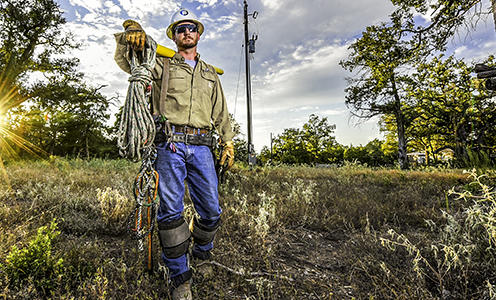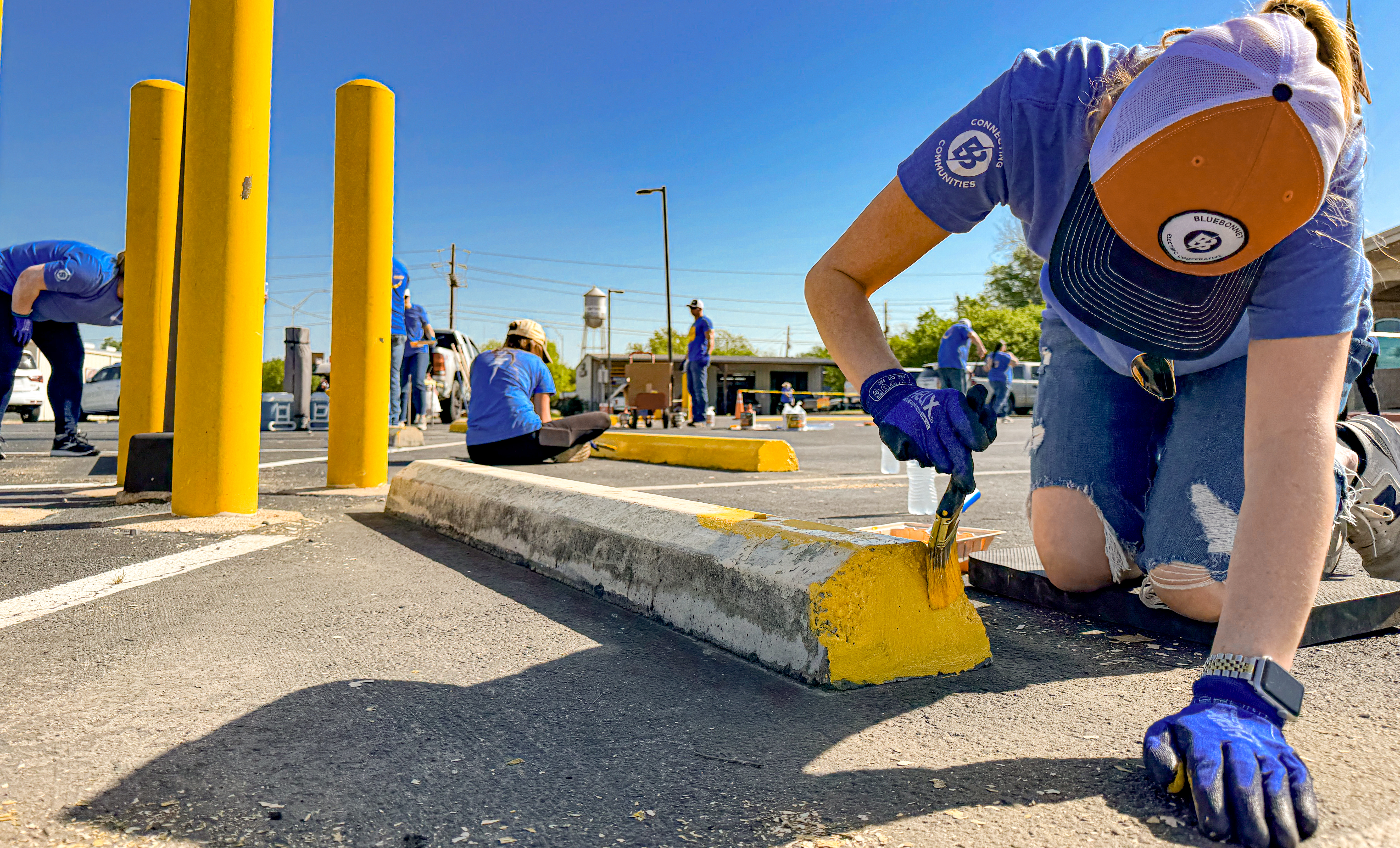The cooperative way
Recent news
From an early age, many rural Texas children take on the responsibility
of raising animals, gaining hands-on experience and valuable life skills.
Youth livestock shows have been part of Texas’ heritage for decades. For kids growing up in rural areas, the traditions and culture of the shows provide a sense of purpose and a connection with their communities and the land. Many start raising chickens, rabbits, goats, lambs, pigs or cattle at a young age, hoping to showcase the animals at local competitions and use prize money to pay for the animals' care and their own college funds.
Shows take place across the state each spring and fall, but the real work happens between shows, when students learn the ins and outs of livestock management. They wrangle
steers without halters, cuddle rabbits with care and parade with persnickety pigs. They also learn how to solve problems on the fly, research best practices of care, record their progress and develop social skills they’ll use for the rest of their lives. We met 11 hardworking young livestock show participants from all over the Bluebonnet region. With an array of backgrounds and a variety of livestock, they all share a passion for their animals and the youth agricultural community.
— Addie Broyles
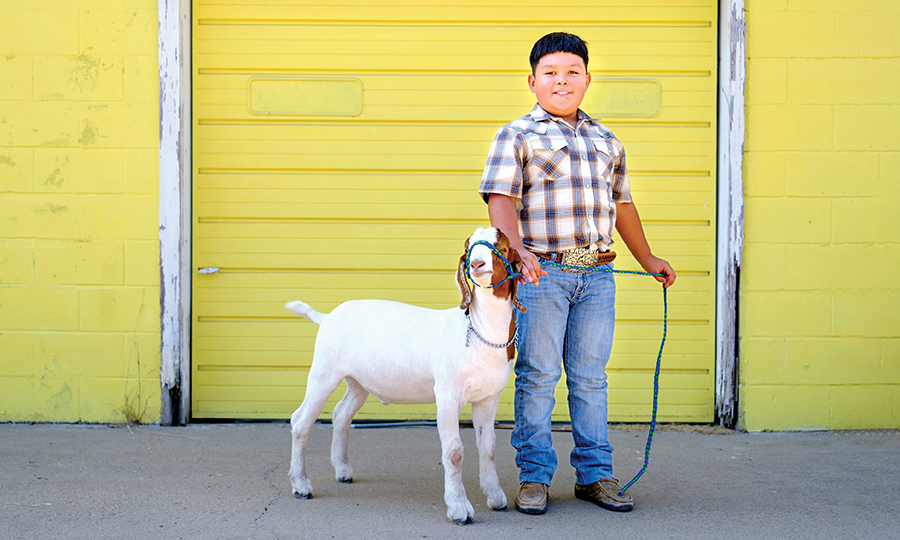
Three seasons into his junior livestock show career, goat exhibitor Damian Guerrero has racked up several showmanship awards. The 11-year-old Cedar Creek Intermediate School student moves with the agility of a boxer, swiftly pivoting to keep his eyes on the judge and the judge’s eyes on him. Damian, the son of Juan and Amanda Guerrero, exhibited three male goats in 2023 and 2024: Buster, Whiskey Effort and Shorty. He closed out the 2024 season by winning showmanship titles and two reserve market goat championships with Shorty at the Bastrop Area Livestock Show. Damian is now training new goats with hopes of earning more championship buckles.
— By Camille Wheeler, photo by Laura Skelding
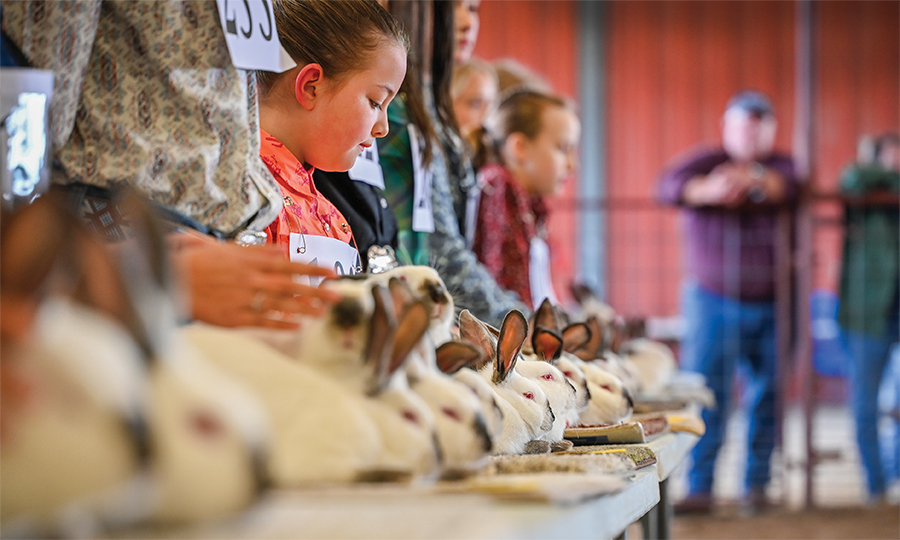
Showing rabbits takes poise, patience and a gentle touch, said Lockhart 4-H member Nellie Garcia.
“They don’t like being picked up,” added the 9-year-old, softly. “You have to pick them up like a cat.” All of Eric and Kelley Garcia’s three children participate in the Caldwell County Junior Livestock Show, showing rabbits and pigs. Nellie couldn’t wait to join 4-H in third grade because she watched her two brothers show and it looked fun. “Rabbits are really good for the young ones to start with,” said Nellie’s mom, Kelley, who also showed in 4-H as a youngster in Lockhart. Rabbits need an hour or more of attention each day to make sure they reach the proper weight, have good muscle tone and are comfortable around people. A pro tip from Nellie: If the rabbits are nervous in the show ring, cup your hands over their ears or eyes to help them calm down.
— By Clayton Stromberger, photo by Sarah Beal
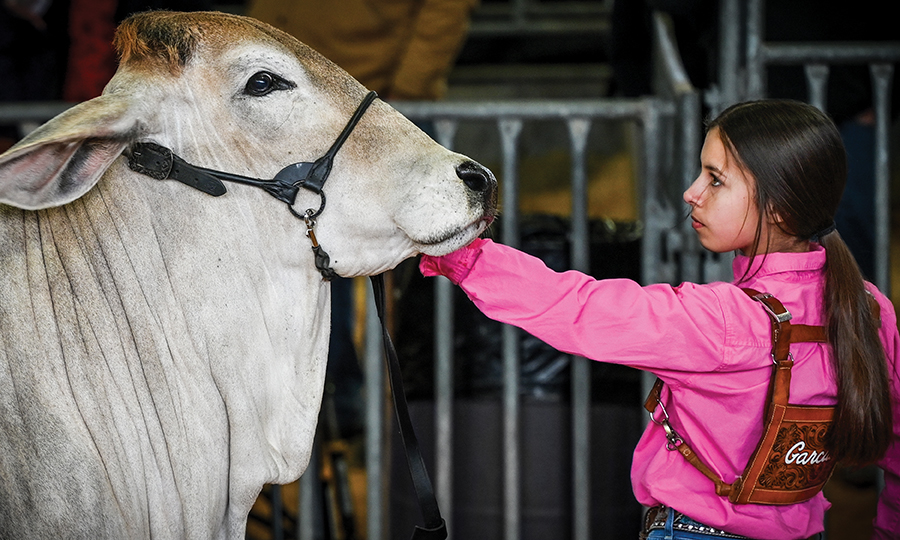
When 15-year-old Jaci Garcia of Giddings, daughter of Daniel Garcia and Kristina Creek, walks into the show ring, she means business. Veteran cattlemen have noted it as well. “She just has a natural eye for cattle,” said Dustin Keith, owner of Keith Cattle Co. in Lincoln, who provided Jaci with her first heifer three years ago. “She’s really eager to learn. She asks good questions, and she listens.” Jaci puts in five hours a day on FFA work, and her commitment and passion have paid off with an array of buckles and ribbons, including grand champion for bred commercial heifers and grand champion gray Brahman last year at the Lee County Junior Livestock Show. Working with Sandy, the feisty 1,600-pound heifer, pictured above, was a challenge. Sometimes Sandy would try to give Jaci a headbutt. When she heard her name proclaimed as grand champion, “I bawled my eyes out,” Jaci admitted with a smile. “Everyone could see how much it meant to me.”
— By Clayton Stromberger, photo by Sarah Beal
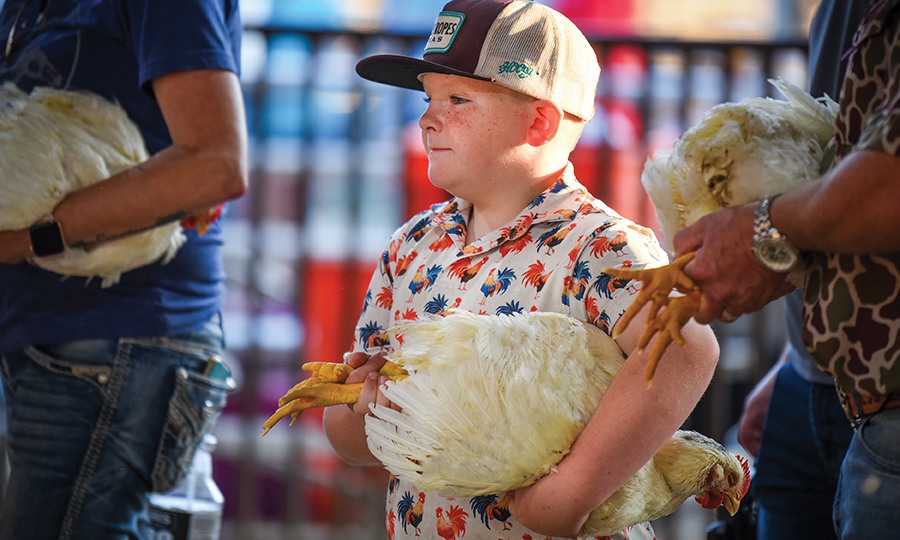
Easton Groce, 10, son of Jared and Rachel Groce, dressed for success at last year’s Burleson County Fair. He wore a colorful chicken-print shirt as he proudly showed his finest fowl. His mother, Rachel Groce, said that the Snook Elementary School fifth grader started showing livestock in third grade, following in the footsteps of his older brother, Teagan. Easton was the second-youngest competitor showing a chicken at last year’s fair, going up against students as old as high school seniors in the market broiler category. “The chickens are pretty heavy,” his mother said. “It’s nerve-racking. People put a lot of pressure on the kids.” But Easton’s got the hunger — and the outfit — to keep going, devoting hours to his chickens leading up to the show. He knows he wants to win grand champion at the county fair.
— By Eric Webb, photo by Sarah Beal
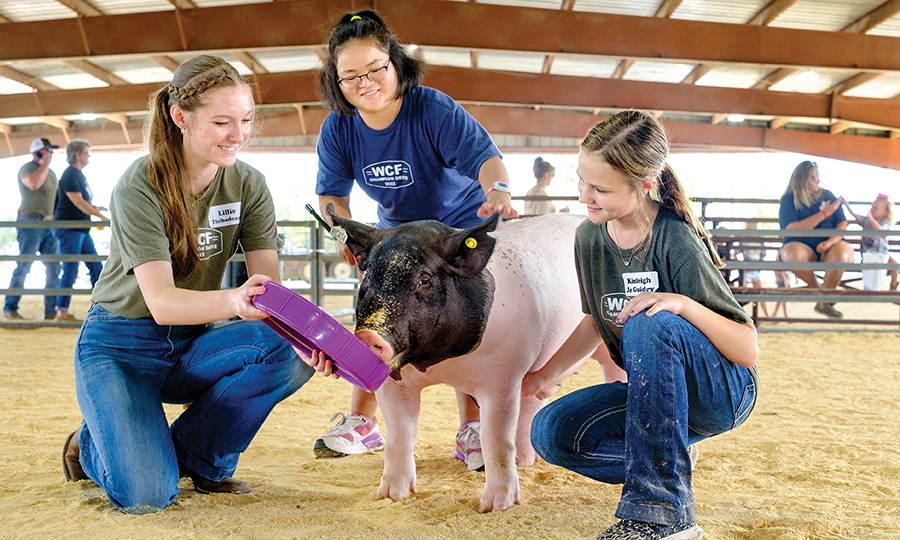
Grace Hyman, 20, can count on her buddies. She teamed with Lillie Thibodeaux (left) and Kinleigh Jo Guidry (right) to show a crossbred barrow pig at the 2023 Washington County Fair Champion Drive. The program, which started in 2014, allows young people with disabilities to participate in livestock shows. Grace graduated in 2023 from Brenham High School. “Special needs kids are often overlooked, put at the back of the class, back of the line,” said her mother, Judy Hyman. Grace’s father, Kelley Hyman, added, “That they have something like this for our special needs kids, where they can be the star, that’s what drew us to this.” Grace loves being around animals, and although she sometimes gets a little stage fright, her friends Lillie, 18, and Kinleigh Jo, 14, helped her feel at ease by feeding the pig in the show ring. It was all a great learning experience, Grace’s mother said, adding, “When you’re showing animals, there’s a confidence you gain.” And, more importantly, Grace had a blast.
— By Eric Webb, photo by Laura Skelding
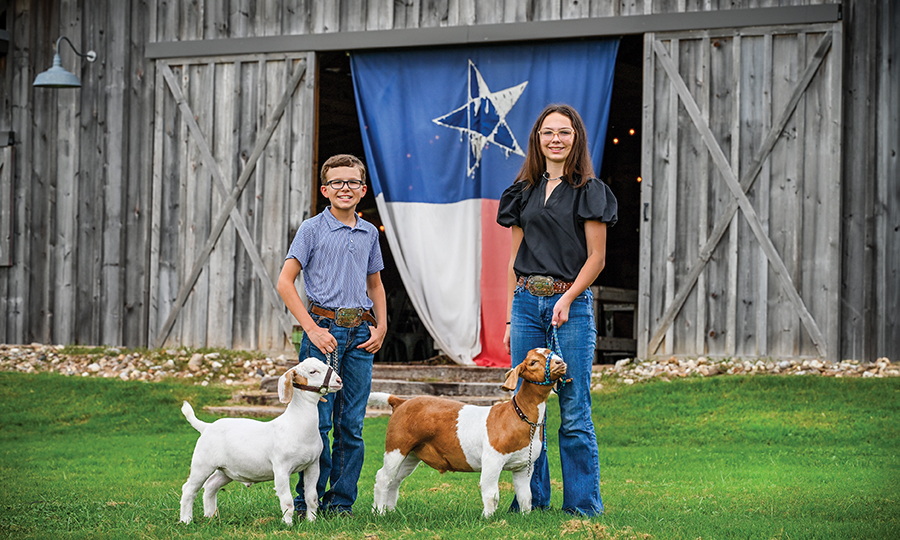
It was brother vs. sister at the Fayette County Junior Livestock Show last year. Tate, left, 11, and Tatum, 13, competed against each other with the market goats they raised at their family’s place near Fayetteville. The siblings, children of Todd and Raegan Fritsch, swept the category, with Tatum winning grand champion and Tate winning reserve grand champion. “They were so happy for each other,” Raegan Fritsch said. At the Houston Livestock Show and Rodeo last year, Tatum won one of 20 calf scramble tickets worth $2,200 to compete in this year’s livestock show. With that money, participants can buy a heifer or steer that they must exhibit the upcoming year. Between her schoolwork and volleyball practice, basketball games and track meets, Tatum also writes a newsletter about raising her steer, named Triple A. If Tatum had her way, her mother said, she’d be doing livestock-related stuff full-time. “It’s all she wants to do.”
— By Addie Broyles, photo by Sarah Beal
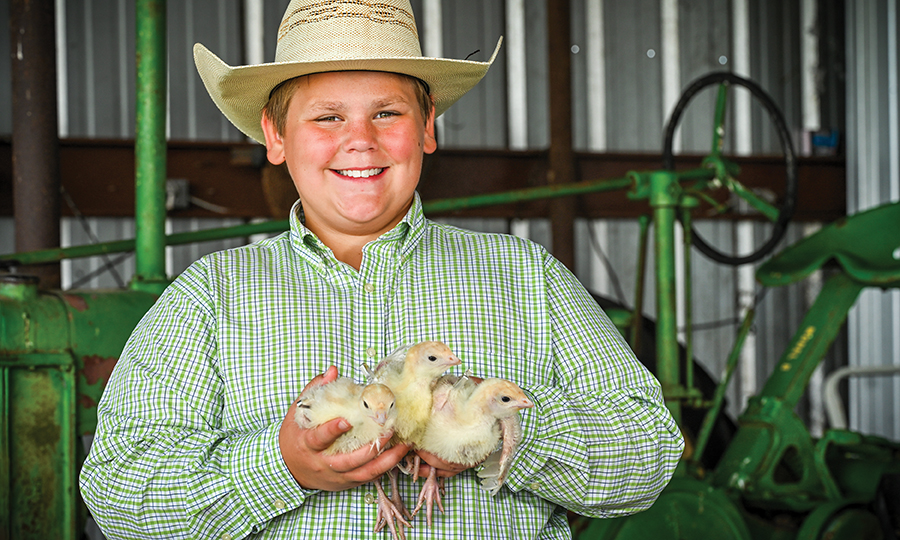
Bailen Kocurek, 13, loves showing heifers and is always up for trying something new. The seventh grader started in 4-H Clover program (for kindergartners through second graders) at age 5. He began showing pigs and heifers in third grade, the first eligible year for 4-H members. “I had to learn a lot that first year,” he said, “but I’ve really grown to like it.” For a change, he raised several dozen turkeys last year, showing his best at the Burleson County Fair. Handy with a sewing machine, a skill taught by his grandmother, Susan Broesche, he even used his talents in a 4-H stitch and design class. A few years ago, he and fellow 4-H members sewed pillows and blankets to bring holiday cheer to area residents.
— By Addie Broyles, photo by Sarah Beal
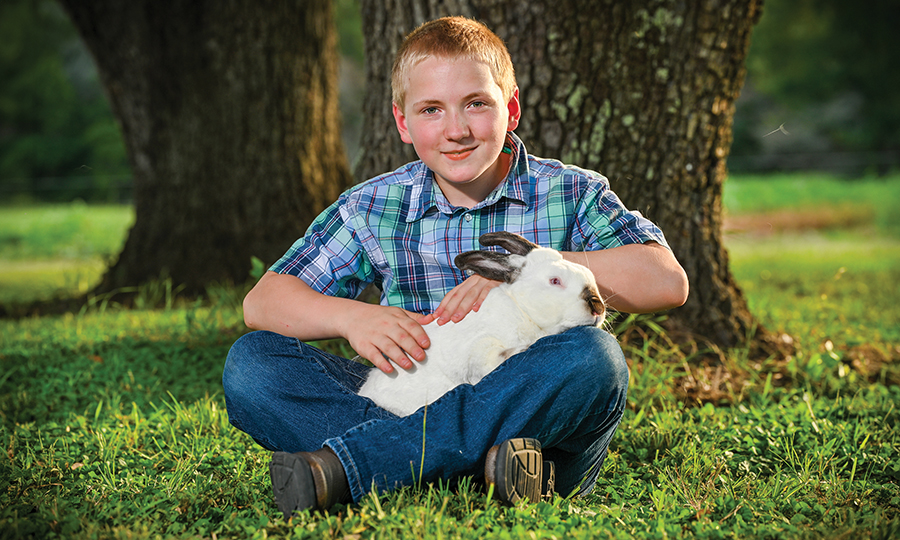
Callan MacDonald, 12, knows that a prize-winning show rabbit has to be in good shape to be a winner. “I run the rabbits around for about 30 minutes a day to help with their condition,” he said. The Manor Middle School seventh grader grew up helping his older brothers show rabbits and pigs. Now, he’s preparing for another year of showing both animals. His dad, Scott MacDonald, and stepmother, Staci Bartos, are both agriculture teachers in Manor. Before third grade, Callan participated in the Travis County Peewee Show, where kids as young as 2 can get experience “showing” animals. For Callan, that meant learning how to handle the rabbits, so his hands do not get too many scratches. “But they get wild, so you never know,” Callan said.
— By Addie Broyles, photo by Sarah Beal
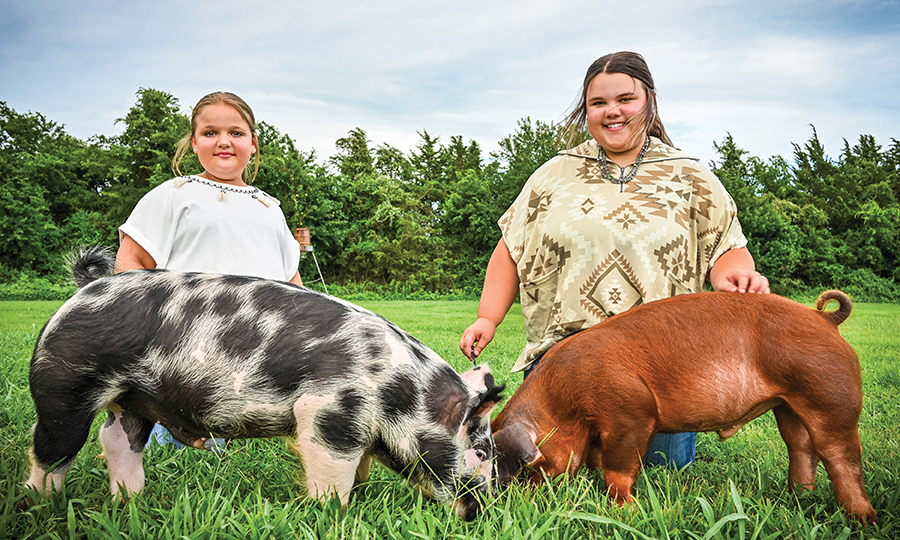
Showing pigs is a Luedke family tradition for Chloe, left, 12, and Darcy, 16. Every year at their farm near Kenney, between Brenham and Bellville, they have raised pigs for fall and spring livestock shows, just like their parents and grandparents did decades ago. The sisters, daughters of Brandon and Rebecca Luedke, started exhibiting pigs in third grade, the first year they were eligible in 4-H. Now they have competed at both local and state shows. In 2023, Darcy placed fifth at the State Fair of Texas and showed the reserve class champion at the Austin County Fair, their hometown show. Chloe showed her pig, Yella, at the show in Bellville last October. Darcy has a strong sense of purpose and wants to work in agriculture: “Agriculture is the backbone of everything,” she said. “My time in 4-H and FFA has made me the person I am today.”
— By Addie Broyles, photo by Sarah Beal
Severe winter events have taught us to be prepared for anything
The most predictable thing about winter in Texas: It’s unpredictable. Although average temperatures in the Bluebonnet Electric Cooperative region rarely drop below freezing, severe winter events have taught us to be prepared for anything. Take these steps to stay safe and prepare your family and home for an unexpected winter-weather emergency.
1. Create a communication plan
• Your family may not be together
when severe weather hits, so create a plan that includes everyone’s role during an emergency.
• Discuss how you will stay in touch with one another.
• Do not rely on cellphones alone,
as service could be lost.
• Create “know your number” contact cards for everyone’s wallet or bag and consider having an out-of-area emergency contact who won’t be affected by the weather.
• Make a plan to regroup at a designated place.
• Decide who is responsible for household pets’ safety.
2. Download apps and save website URLs
• Federal Emergency Management Agency, fema.gov, and American Red Cross, redcross.org, provide emergency notifications and information
about shelters, first aid and recovery assistance.
• The National Weather Service at
weather.gov (type in your area), local
weather apps, the Weather Channel at weather.com, AccuWeather at accuweather.com and WeatherBug at weatherbug.com provide local and regional forecasts and alerts.
• The Texas Department of Emergency Management at tdem.texas.gov has
safety and weather information.
• Drive Texas, drivetexas.org, has
road-closure information.
3. Stock up on supplies
• Store at least a three-day supply
of non-perishable or canned food items and water, one gallon per person
for each day.
• Make a winter-weather emergency kit that includes blankets, extra warm clothes, sleeping bags, a first-aid kit, portable lights, a cell phone charger and walkie-talkies with extra batteries.
• Keep your gas tank full, and stock your vehicle with items such as a battery-powered or hand-crank radio, a towrope and an ice scraper.
4. Prepare your home
• Check heating systems; insulate and seal doors, windows, cracks or holes; repair any roof damage; and clear gutters.
• Secure lightweight outdoor items that could blow away.
• Cut tree branches near or hanging over your roof.
• Ahead of severe weather, insulate exposed pipes, drain outdoor water systems and keep water moving in indoor pipes by dripping all faucets.
• Store a fire extinguisher in a place you can easily reach.
For more tips to stay safe this winter and save money on your electric bill, go here.
Local shelters
The Texas Division of Emergency Management updates a list of available shelters across the state of Texas every hour. If you or someone you know needs a warm place to stay during extreme cold weather, visit tdem.texas.gov/warm to find an available shelter near you.
Bluebonnet Electric Cooperative and LCRA representatives present a $23,819 grant to the Prairie Hill-Rocky Hill Volunteer Fire Department for new vehicle extrication tools. The grant is part of LCRA’s Community Development Partnership Program. Pictured, from left to right, are: Kyle Merten, Bluebonnet's Brenham-area community representative; Robert Mikeska, Bluebonnet Board secretary/treasurer and member; Margaret D. “Meg” Voelter, LCRA board member; Doyle Dahmann, VFD fire chief; Douglas Zwiener, VFD deputy fire chief and chief financial officer; Ron Arnold, VFD firefighter; and Kate Ramzinski, LCRA regional affairs representative.
The Prairie Hill-Rocky Hill Volunteer Fire Department will soon purchase its first set of battery-operated vehicle extrication tools, thanks to a $23,819 grant from Bluebonnet Electric Cooperative and the Lower Colorado River Authority.
The Community Development Partnership Program grant, combined with $5,955 in matching funds from the VFD, will equip firefighters with new rechargeable tools that will enable firefighters to reach people trapped in vehicles more quickly and efficiently.
“This is a project we’ve been working toward for several years,” said Douglas Zwiener, deputy fire chief and chief financial officer of the Prairie Hill-Rocky Hill Volunteer Fire Department. “While we’ve been fortunate to rely on the Brenham Fire Department for extrication tools, having our own equipment will enable us to respond faster and more efficiently to emergencies in the northeastern part of Washington County. Every second matters in critical situations, and these tools will greatly enhance our ability to serve our community.”
Founded in 1959 by local farmers, the Prairie Hill-Rocky Hill VFD has grown into a multi-apparatus department that provides essential fire suppression and rescue services to a 63-square mile area of northeastern Washington County. The department also responds to calls in parts of Brenham, Burton, Chappell Hill, Lake Somerville and other nearby communities.
“This grant, along with past support from LCRA and Bluebonnet, has elevated our department’s readiness,” Zwiener said. “Whether it’s generator backup for our fire hall, ATV access for hard-to-reach areas, or now these extrication tools, this support ensures we’re prepared to handle a wide range of emergencies and serve the residents of Washington County more effectively.”
The community grant is one of four grants being awarded by Bluebonnet and LCRA through LCRA’s Community Development Partnership Program, which helps volunteer fire departments, local governments, emergency responders and nonprofit organizations fund capital improvement projects in LCRA’s wholesale electric, water and transmission service areas. The program is part of LCRA’s effort to give back to the communities it serves. Bluebonnet Electric Cooperative is one of LCRA’s wholesale electric customers and is a partner in the grant program.
Applications for the next round of grants will be accepted in January 2025. More information is available here

